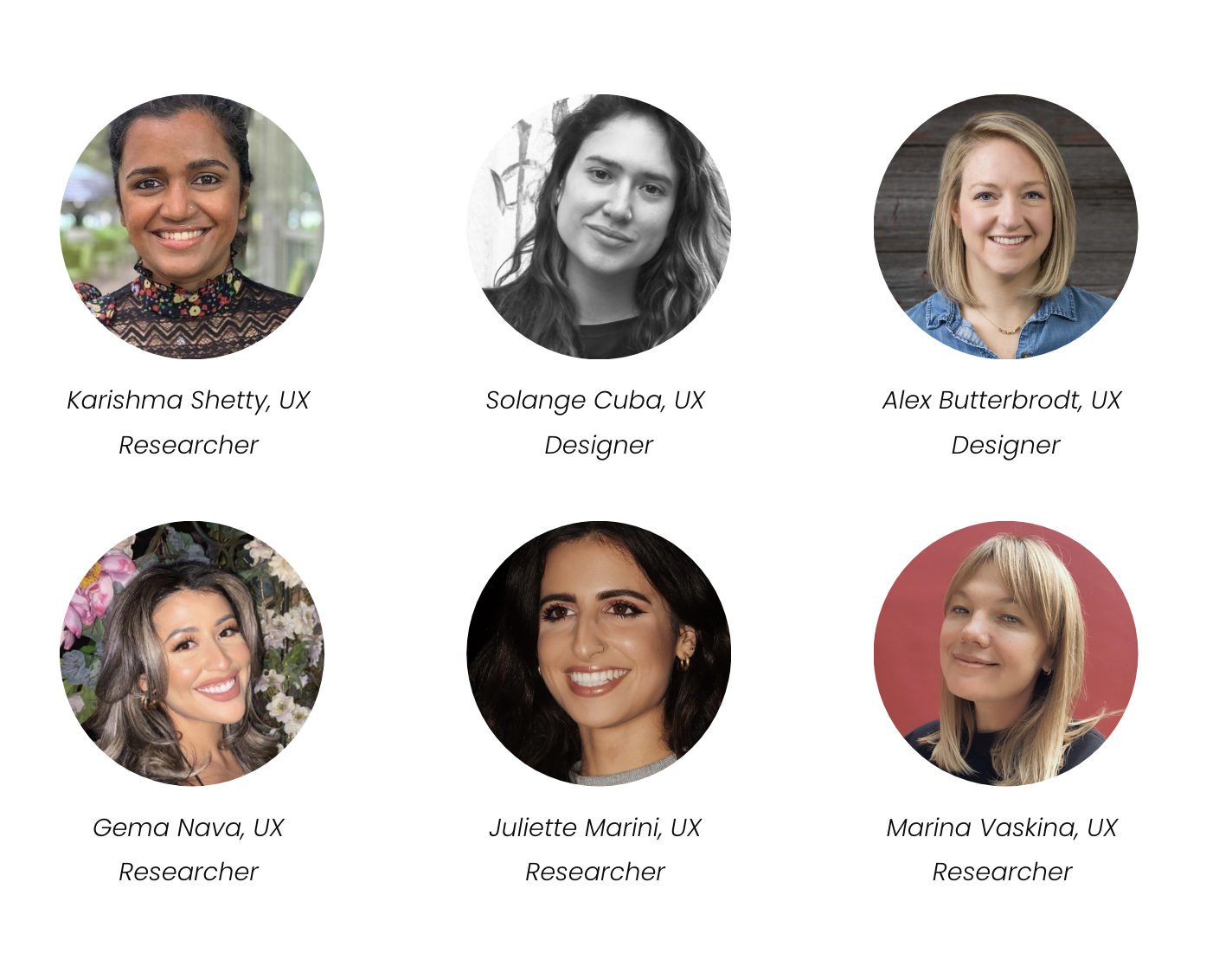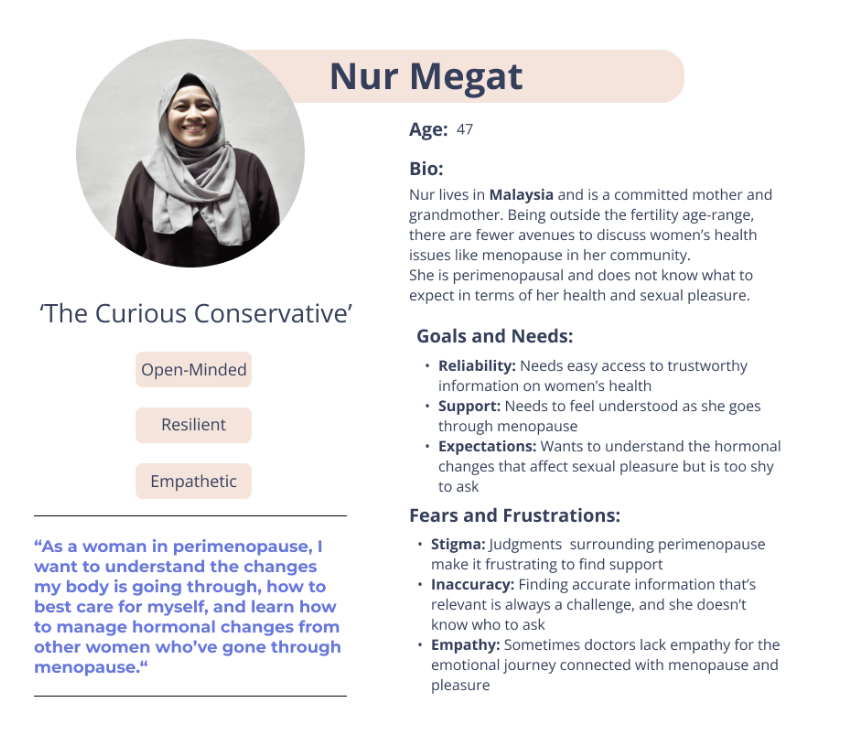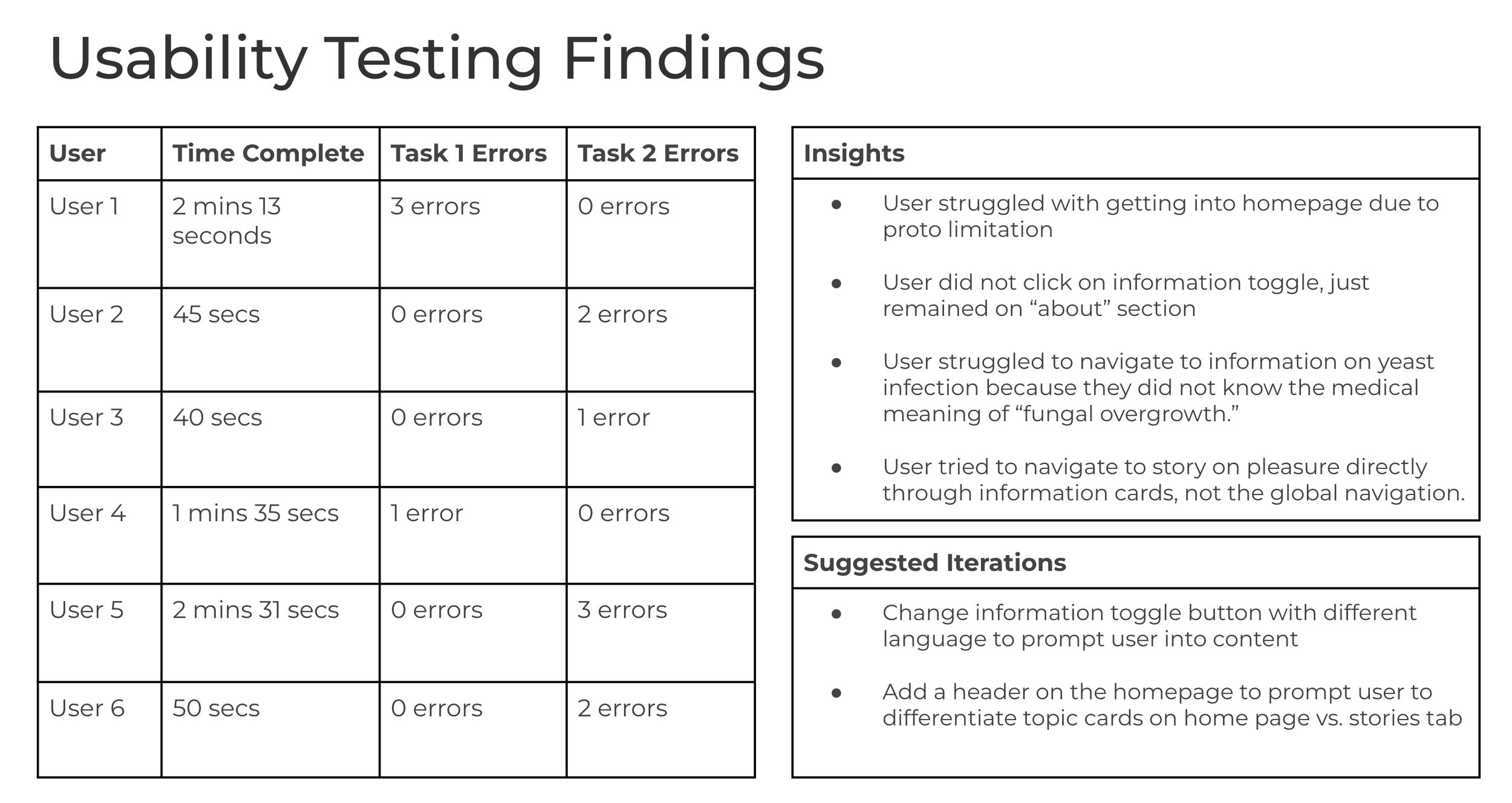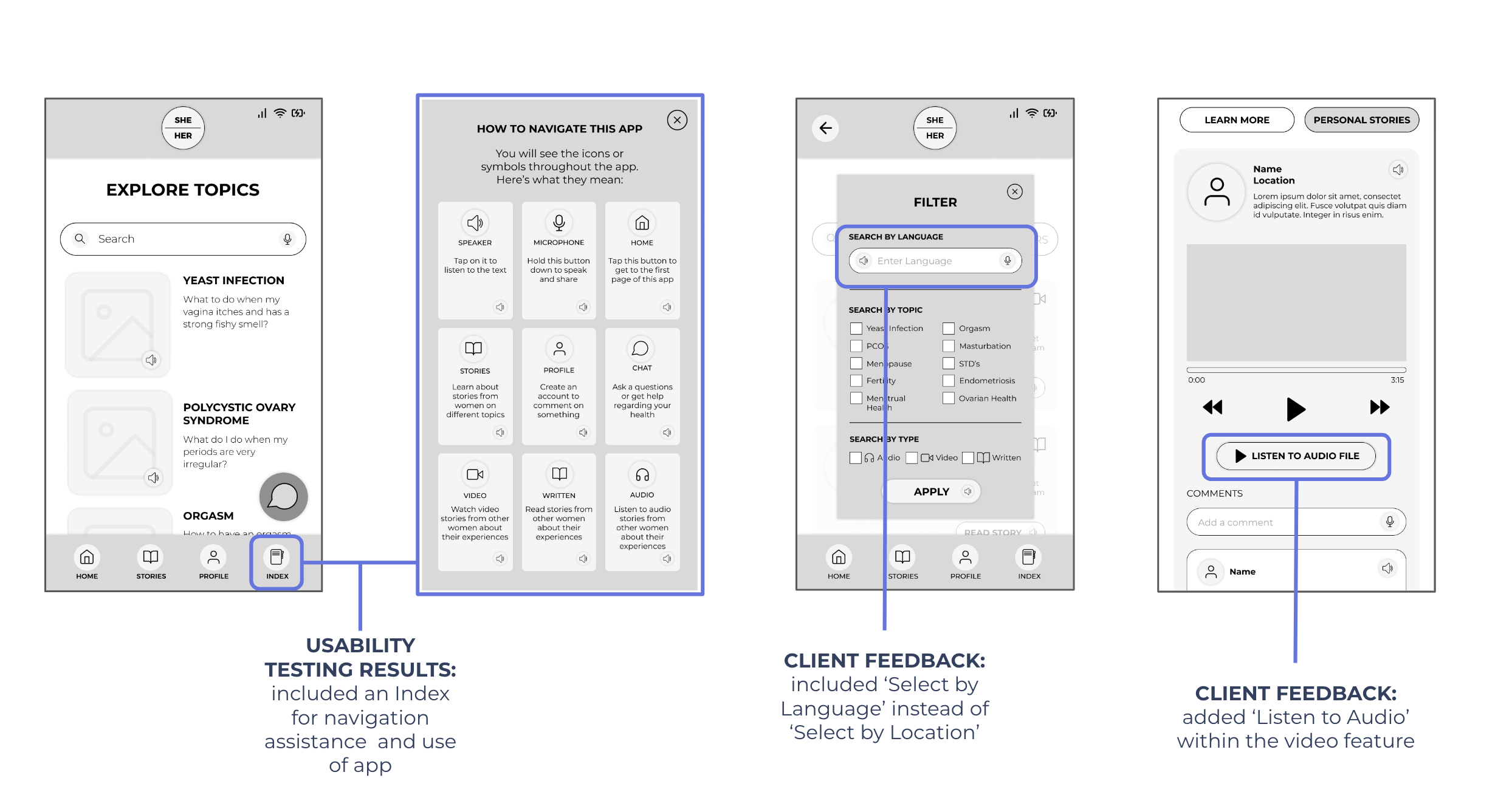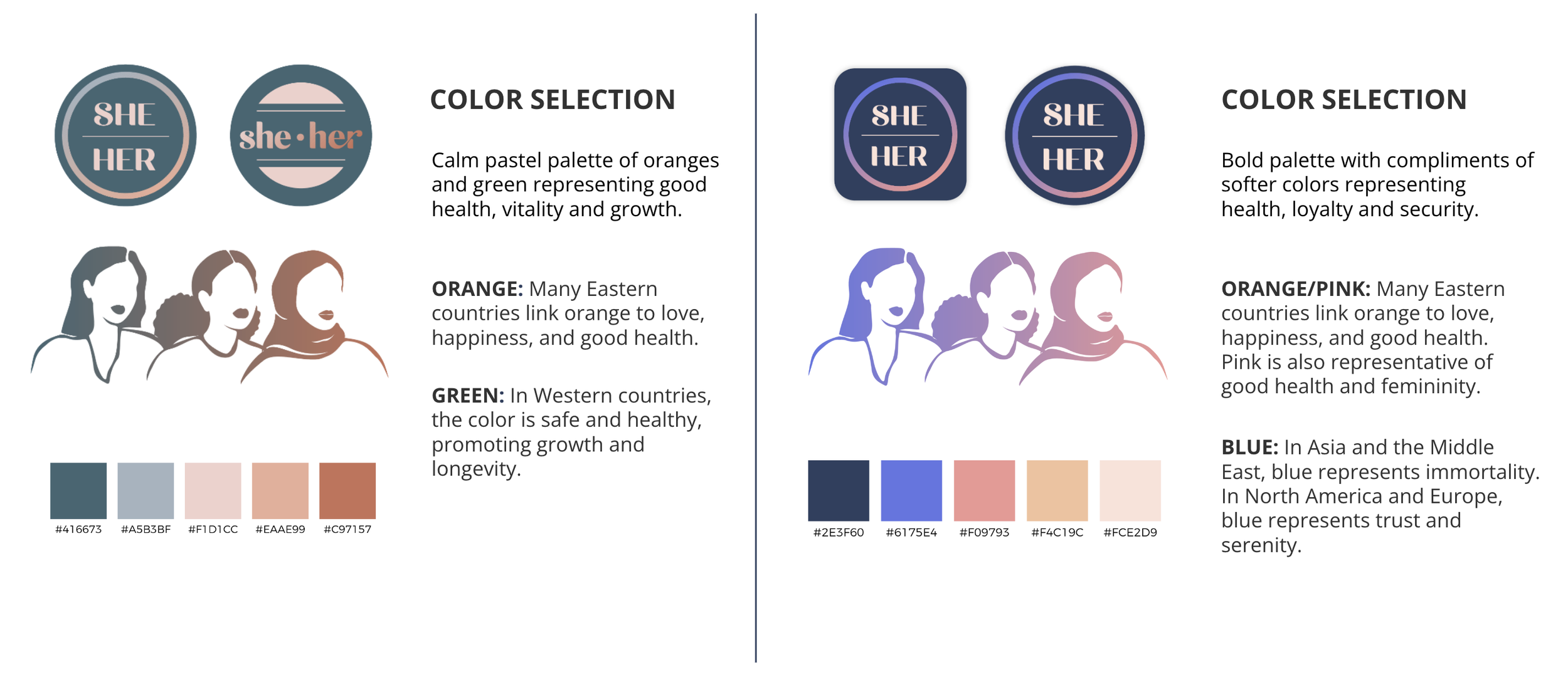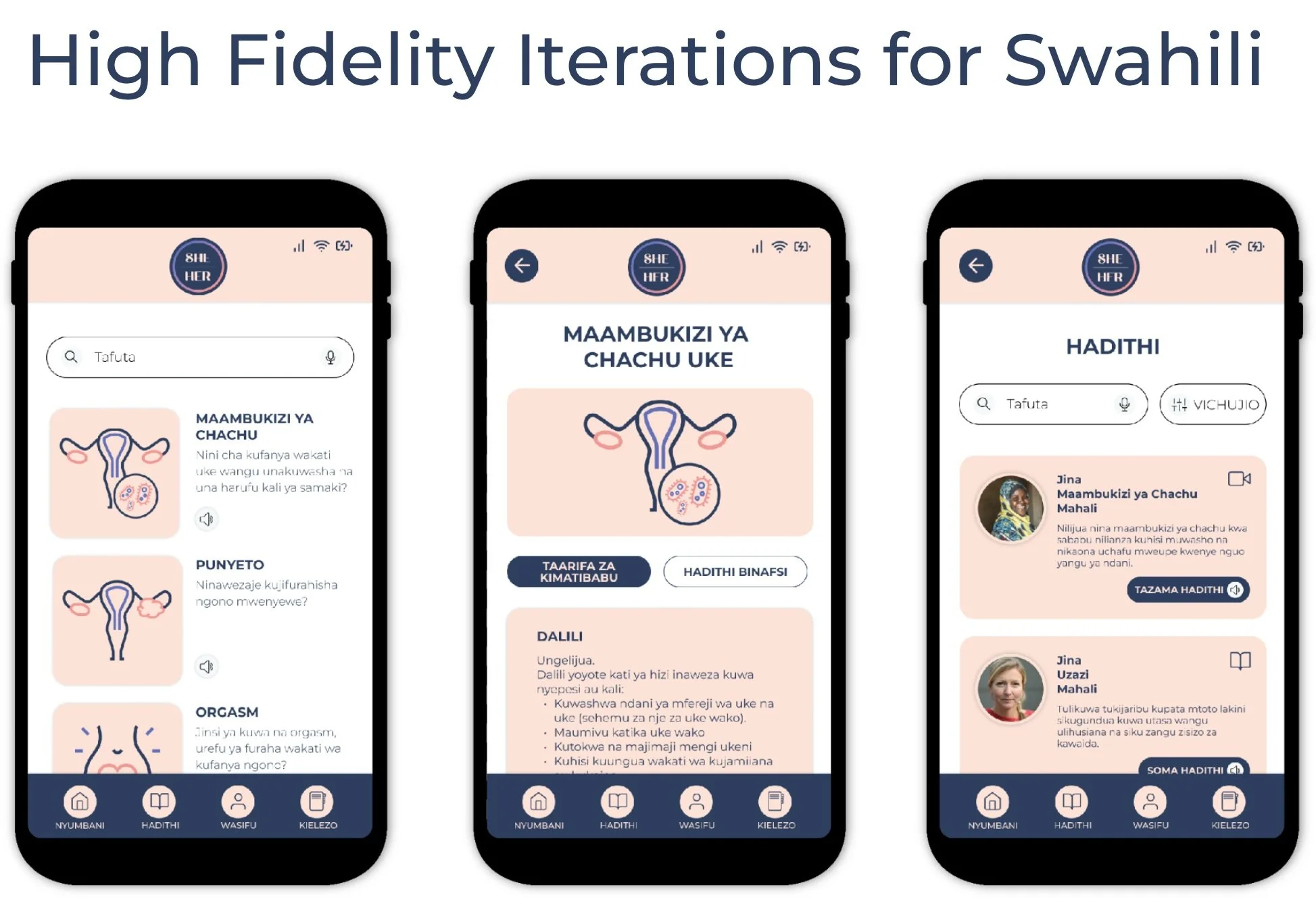Enhancing Accessibility in Women's Health
Final high fidelity prototype for She/Her App
My Role: UX Researcher
Timeframe: 12 weeks
Tools Used: Figma
Deliverables: Case Study, Responsive High-Fidelity Mobile App, Iteration in Arabic
Key Methods: User Interviews, Secondary Data Analysis, Usability Tests, Surveys, Wireframes, Prototyping
UX Process
Where Do We Come In?
In April 2020, our client, Hanai Health, launched a fully localized app with tailored information on maternal health called Jiwa Ibu. It has supported 3,000+ indigenous people to date.
Now, Hanai Health wants to provide support through women’s shared experiences from pain to pleasure in an app called She/Her. This app aims to fill the gap of information for women who need resources with regard to their sexual health.
Our team took on the challenge.
Challenges and Constraints Considered
-
Representative users for our case study lived in North America, Germany, Malaysia, and Tanzania.
-
It was important to consider literacy levels, internet connection, and the types of devices that users would be using when using the She/Her app.
-
Our client emphasized the importance of language variability and accessibility. We conducted research to inform design iterations in Arabic and Swahili, which you can find near the end of this case study.
-
Health-related topics require high levels of confidentiality. We ensured that our research directed us toward understanding how to better provide privacy to users.
-
As we worked to design an app for women to access information about their sexual health, we made sure to conduct research with a trauma-informed approach and considered socio-cultural impacts that may affect how people interact with the She/Her app.
Primary Research
-
In order to ensure improvements in access, we conducted a feature inventory between comparable organizations that provide a range of essential services including education, healthcare, and emergency assistance. A feature inventory provided insight into how language, location, and services are considered.
We conducted a feature inventory between Jiwa Ibu, Aya Contigo!, Unrwa, and Nejat.
-
We conducted 5 interviews with women from Malaysia, Luxembourg, and the US in order to adequately gauge user behaviors and to understand how people will benefit most from a women’s health app.
Our objective:
To understand what women with varying medical histories need from a women’s health app.
-
In an effort to gather more information about potential users, we created a brief user survey to gauge how women in Malaysia might feel about accessing information about their sexual health on an app.
-
We gathered qualitative data from 3 subject matter experts in Tanzania on topics such as:
Access to sexual education
Women’s Health
Socio-cultural factors
Access to educational resources
Internet accessibility
Secondary Research
In addition to primary research, we conducted extensive secondary research to better understand country conditions in Tanzania and to address the needs of users that we did not have contact with.
We utilized scholarly articles, research on behavioral design for women’s health and marginalized communities, as well as design thinking in other cultures to help inform:
Literacy rates in Tanzania
Access to educational resources
Interface accessibility
Cultural sensitivity
Internet access points in rural communities
Our research led to insights that would inform our secondary persona for She/Her.
Primary Persona
-
We asked about 15 open-ended questions to gather insights from users during user interviews. Some of which included:
Can you tell me about a time when you searched for something related to your body online?
Can you tell me about a time when someone shared an intimate story related to their health or sex life with you?
If you knew that there were others who experienced things similar to you, what would you like to learn from their stories?
-
Direct quotes from research synthesis through affinity mapping include:
“I was experiencing a hormonal disorder, but my doctor told me that it was just depression. When I questioned it, he said, ‘who’s the gynecologist, you or me?’”
“[In] the community and culture I grew up in, women are not allowed to share their sexual experiences or health problems.”
“We were only educated about the science of sex.”
-
We found that women:
Do not know how to find support
Want their experiences validated
Want to support women’s shared experiences
Feel frustrated by the lack of relevant information
-
After discovering key insights, we asked ourselves, how might we:
Make women’s experiences feel validated?
Ensure women’s privacy is protected?
Empower women?
Ease the process of finding information?
Meet Nur! She is based on direct user research and insights from user interviews. Nur Megat is the primary user of the She/Her app.
Secondary Persona
Meet Zahra! She is based solely on SME Interviews and secondary research. Zahra Mwita is a secondary persona and an important user of the She/Her app.
Design Solution
Based on detailed user research, we found that women from various ethnic communities feel unsupported regarding their sexual and reproductive health and need a platform to gain information and learn from other women’s experiences but don’t know where to go.
We needed to create an accessible platform where women from various ethnic communities with varying literacy levels can share their experiences. The result will be helping them make the right decisions for their sexual and reproductive health because they feel validated and empowered.
Lo-Fi Wireframes
-
We took our design solution into a design studio where we then transformed final ideation sketches into low-fidelity wireframes using Figma.
Key elements:
Audio and microphone for vocal interaction, keeping in mind accessibility
PIN for privacy
Topic cards with image emphasis for visual aid
Stories tab for shared experiences to help women feel validated through personal stories
Help function for navigation assistance
Toggle and filter buttons to ease the flow of finding information
-
After finalizing all low fidelity wireframes, we prototyped while keeping in mind a user task flow that takes you from the home page to a topic card on a health condition and a personal story on a shared experience.
Usability Tests
We conducted 6 usability tests and provided users with a scenario based on Nur’s needs in order to address potential issues with our design solution or user flow.
-
Task 1: Sign up and navigate to information on a specific topic.
Task 2: Navigate to a written story about pleasure.
-
User will be able to navigate to the specific medical information on yeast infections and find a specific story relating to orgasms in 2 errors or less and in less than 3 minutes total for both tasks.
Design Iterations
Usability testing proved to be critical in our design process. We made iterations based on usability testing but also based on client feedback that we validated through research.
Branding
We presented our client, Hanai, with color and branding options. The palettes chosen were founded on research and considered the use of color through a socio-cultural lens.
Style Guide
After receiving feedback from our stakeholders, we finalized a complete style guide for the She/Her app, including typography and an icon library.
Hi-Fi Prototype
Final high fidelity English prototype.
Swahili and Arabic Iterations
These iterations show how our design looks when directly translated into a different language and for a language that reads from right to left.
Next Steps
Learnings + Findings:
Learned of the spectrum of women’s needs based on actual research
Cultural nuances
Accessibility
A mesh of technical and personal constraints means we had to constantly rethink our solutions from many different perspectives
Next Steps:
Working with Hanai to expand the secondary persona
Building more accessibility features based on research
Chatbot feature to be able to assist people in real-time
Collaborating with engineer on design


